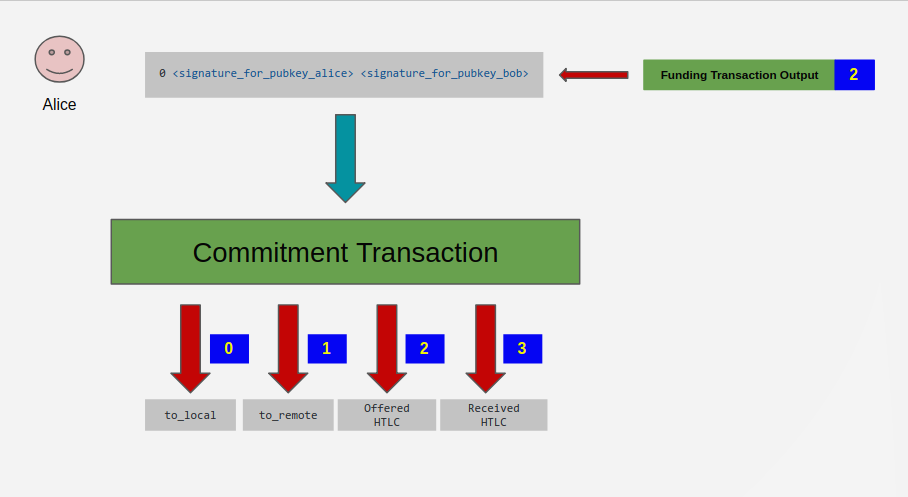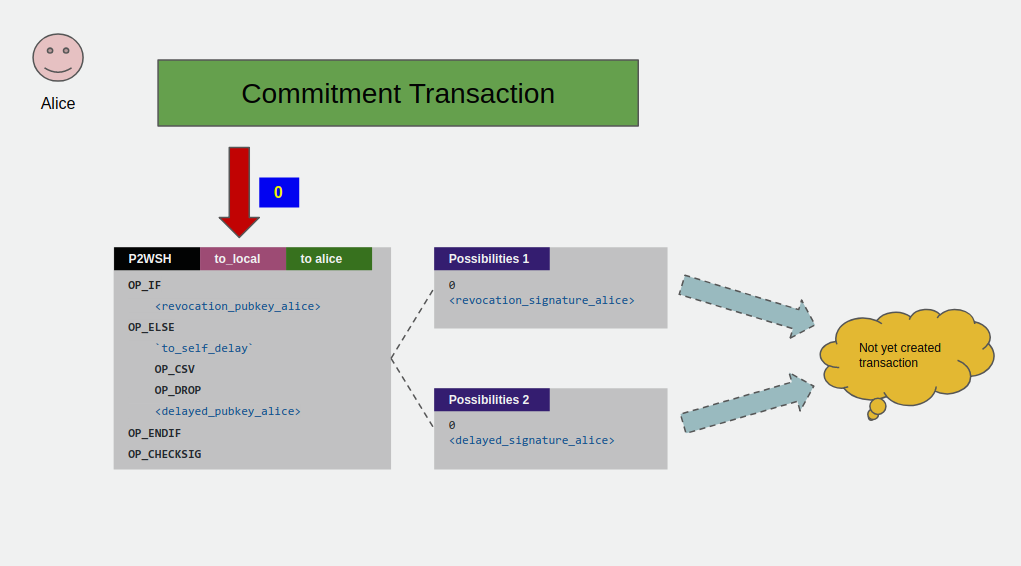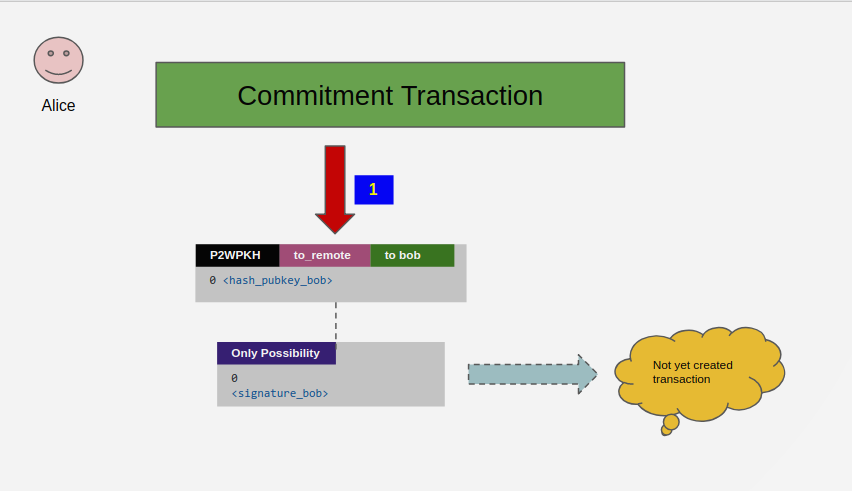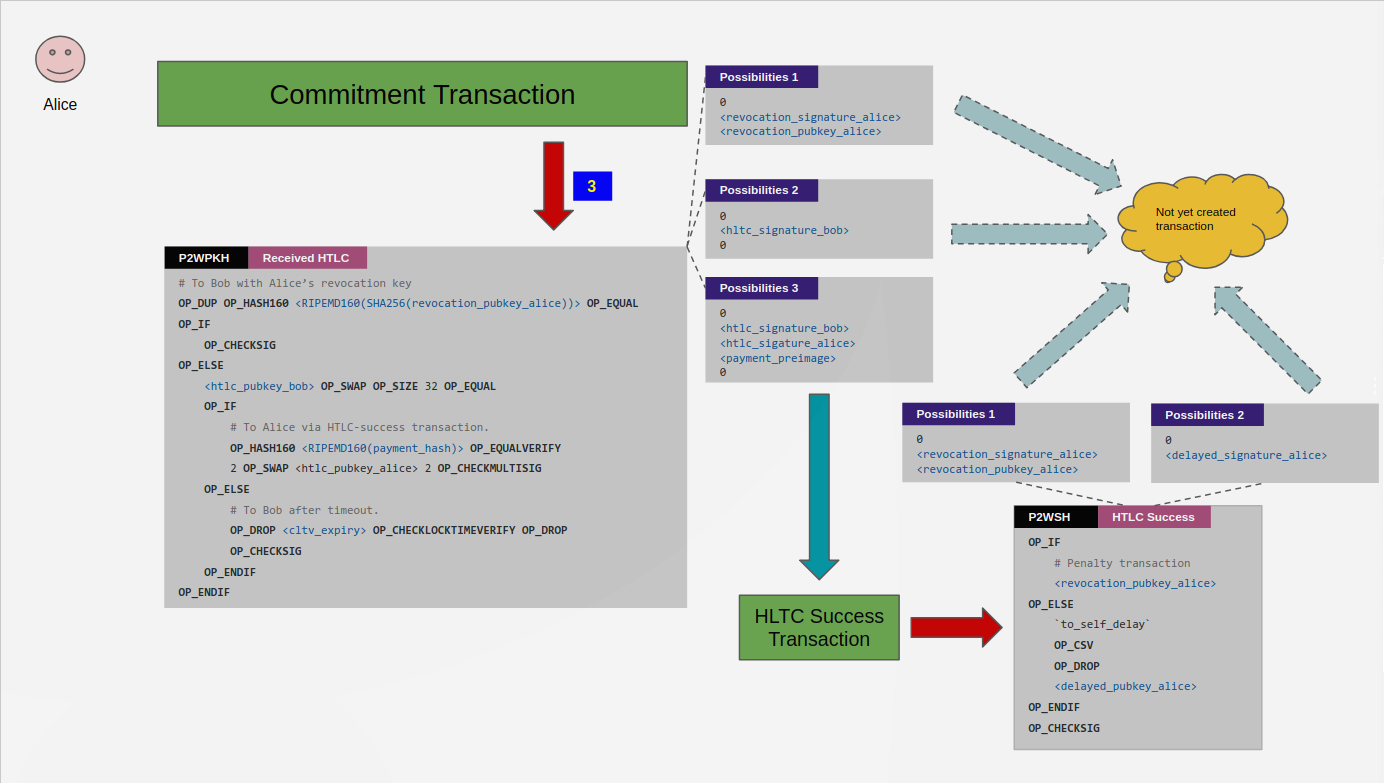Payment Channels in Lightning Network
One of the fundamental aspects of the lighting network protocol is how payment channels are established and utilized to transfer funds. Just like TCP connection, payment channel is virtual in the sense that it is achieved by carefully designed smart contracts which gives user the illusion that there exists a channel. In this post, the smart contracts expressed in Bitcoin script in different types of transactions within the lightning payment channel are discussed in details, with graphs illustrating their potential behaviors under different scenarios.
Funding Transaction
Assuming that Alice and Bob want to establish a lightning channel between themselves, a transaction with a 2-of-2 multisig output that requires both of their signatures to unlock needs to be committed to the blockchain. This is called a funding transaction.
As illustrated above, inputs of the funding transaction are usually (but not neccessarily) contributed by Alice and/or Bob. Output 0 and 1 represents the potential changes going back to the addresses that Alice or Bob controls. What’s important is output 2 which contains a P2WSH multisig script that locks up the total fund for the lifetime of this payment channel between Alice and Bob.
One obvious risk is that if either party disappears, neither of them will be able to get their money back. This is one of the issues that commitment transaction is designed to address. For now, what we need to know is that commitment transactions always spend the multisig output of the funding transaction. As long as Alice and Bob broadcast the funding transaction together with the first pair of commitment transactions, they will abtain the ability to get their funds back after a timeout.
Commitment Transaction
After funding transaction is confirmed onchain, Alice and Bob can start updating the balance between themselves offchain using commitment transactions. Each commitment transaction can be thought of as a legal contract between Alice and Bob dictating how the balance should look like in different scenarios. Since the contracts are expressed in Bitcoin script, they could be enforced at any time if either party choose to unilaterally broadcast it to the Bitcoin network. With that in mind, Alice and Bob can confidently conduct unlimited number of commitment transactions knowing that no one can be cheated during the process. This essentially turns payment channel into a cache where most the intermidiate balance updates get resolved offchain, with onchain transaction only needed in case of disputes or final settlement, making Bitcoin network much more scalable.
Major design goals of the commitment transaction are:
- Payment can be made in both ways.
- Participants are guaranteed to be refunded after a certain period of time if the counterparty disappears.
- Only the latest mutually agreed upon transaction is valid.
- It should be indistinguishable whether participants are the originator or final recepient of the payment or if the payment is just being relayed by them.
Commitment transactions always unlock the 2-of-2 multisig output of the funding transaction which, as illustrated above, requires both Alice and Bob’s signatures. It is important to realize that each commitment transaction has an asymmetric version and the pair are held seperately by each participant. This pair of commitment transactions are functionally similiar but with built-in mechanisms to penalize its holder if they try to cheat. Both version can be submitted independently if needed, only one of them will succeed since they spend the same output.
Commitment transaction could potentially have 4 outputs. Use Alice’s commitment transaction as example, they are:
- to_local Represents Alice’s current balance.
- to_remote Represents Bob’s current balance.
- Offered HTCL Represents payment that flows from Alice to Bob.
- Received HTLC Represents Payment that flows from Bob to Alice.
Note that these outputs do not neccessarily exist in all commitment transactions. For example, if there is no payment flowing from Alice to Bob, Alice’s commitment transaction will have no Offered HTCL output.
In the following sections, each type of outputs is discussed in greater details.
to_local
to_local output represents the current balance of the holder in the channel, in our case Alice, through a Revocable Sequence Maturity Contracts (RSMC). The purpose of RSMC is to ensure that all previous balances can be revoked when the agreement for a new balance is reached between Alice and Bob.
In Alice’s commitment transaction, RSMC in the to_local output can be encoded in the following scriptSig:
OP_IF
<revocation_pubkey_alice>
OP_ELSE
`to_self_delay`
OP_CSV
OP_DROP
<delayed_pubkey_alice>
OP_ENDIF
OP_CHECKSIGIf the commitment transaction is the latest mutually agreed one, Alice will be able to spend this output after some delay with delayed_signature_alice. The delay is delibrately put in place to give Bob some time to exercise
the breach remedy clause if Alice happens to break the agreement by spending this output after it becomes outdated. In fact, all outputs that return funds to the holder of
the commitment transaction must be delayed for to_self_delay blocks for the same reason.
When the commitment transaction was just created, only Alice knew revocation_pubkey_alice’s corresponding private key revocation_secretkey_alice. Assuming that Alice and Bob decide to create a new commitment transaction, Alice needs to share her revocation_secretkey_alice with Bob so that if Alice publishes the old commitment transaction to the Bitcoin network, Bob can use it to compute revocation_signature_alice and potentially claim the fund in to_local output ahead of Alice (because of the delay).
Bitcoin doesn’t natively support the concept of transaction revocation, RSMC essentially offers such a functionality by making an older output undesirable to spend by both parties.
However, this requires Bob to be online often and constantly monitor the network, something that is not always possible, that is where WatchTower comes into the picture.
to_remote
to_remote represents the current balance of holder’s counterparty in the channel, in our case Bob. Since Bob is unable to broadcast Alice’s version of commitment transaction, no breach remedy clause is needed here. The output can be spent immediately by Bob if signature_bob is provided.
Offered HTLC
Offered HTLC represents the payment flowing from the holder of the commitment transaction to his/her counterparty, in our case, from Alice to Bob. HTLC stands for Hash Time Locked Contracts, which essentially says “I will pay you this amount if you show me the answer to this quiz within a certain period of time, otherwise the fund returns back to me”. Like the to_local output, Offered HTLC also contains a breach remedy clause in case Alice violates the agreement by publishing an outdated version of the commitment transaction.
In Alice’s commitment transaction, Offered HTLC can be expressed in the following scriptSig:
% To Bob with Alice’s revocation key
OP_DUP OP_HASH160 <RIPEMD160(SHA256(revocation_pubkey_alice))> OP_EQUAL
OP_IF
OP_CHECKSIG
OP_ELSE
<htlc_pubkey_bob> OP_SWAP OP_SIZE 32 OP_EQUAL
OP_NOTIF
% To Alice via HTLC-timeout transaction (timelocked).
OP_DROP 2 OP_SWAP <htlc_pubkey_alice> 2 OP_CHECKMULTISIG
OP_ELSE
% To Bob with preimage.
OP_HASH160 <RIPEMD160(payment_hash)> OP_EQUALVERIFY
OP_CHECKSIG
OP_ENDIF
OP_ENDIFBob can spend the output immediately by providing hltc_signature_bob and payment_preimage within a certain period of time. payment_preimage is the answer to the quiz (preimage of a hash) that Alice requires Bob to come up with to be able to claim the fund. No breach remedy clause is needed here.
Alice can spend the output after a delay by providing htlc_signature_bob and htlc_sigature_alice via a seperate HTLC timeout transaction, which in turn locks up the fund in a RSMC contract. htlc_signature_bob is shared by Bob to Alice during the construction of this commitment transaction. As we can recall, RSMC contract contains a to_self_delay value which specifies the time limit within which the counterparty can exercise the breach remedy clause. The nLockTime for the HTLC timeout transaction is set to cltv_expiry, which represents the delay after which the HTLC times out. The reason for needing a seperate HTLC timeout transaction is that it allows HTLC to timeout before breach remedy can be exercised. Otherwise, the required minimum timeout on HTLCs is lengthened by the delay for breach remedy, causing longer timeouts for HTLCs traversing the network.
The locking script for Alice’s HTLC timeout transaction can be encoded in the following scriptSig:
OP_IF
% Penalty transaction
<revocation_pubkey_alice>
OP_ELSE
`to_self_delay`
OP_CSV
OP_DROP
<delayed_pubkey_alice>
OP_ENDIF
OP_CHECKSIGIt can either be spent by Alice using delayed_signature_alice after the delay for breach remedy, or by Bob using revocation_signature_alice if Alice publishes the outdated version of the transaction.
Received HTLC
Received HTLC represents the payment flowing to the holder of the commitment transaction from his/her counterparty, in our case, from Bob to Alice. Similiar to Offered HTLC, Received HTLC also contains a breach remedy clause in case the owner (Alice) violates the agreement by publishing an outdated version of the commitment transaction.
In Alice’s commitment transaction, Offered HTLC can be expressed in the following scriptSig:
% To Bob with Alice’s revocation key
OP_DUP OP_HASH160 <RIPEMD160(SHA256(revocation_pubkey_alice))> OP_EQUAL
OP_IF
OP_CHECKSIG
OP_ELSE
<htlc_pubkey_bob> OP_SWAP OP_SIZE 32 OP_EQUAL
OP_IF
% To Alice via HTLC-success transaction.
OP_HASH160 <RIPEMD160(payment_hash)> OP_EQUALVERIFY
2 OP_SWAP <htlc_pubkey_alice> 2 OP_CHECKMULTISIG
OP_ELSE
% To Bob after timeout.
OP_DROP <cltv_expiry> OP_CHECKLOCKTIMEVERIFY OP_DROP
OP_CHECKSIG
OP_ENDIF
OP_ENDIFBob can spend the output by providing htlc_signature_bob after cltv_expiry has passed, meaning that the fund returns to the sender when HTLC times out. If Alice figures out the preimage of the hash and spends the output by providing htlc_signature_bob, htlc_signature_alice and payment_preimage, the fund will be locked up in a HTLC Success transaction, which looks almost identical to the HTLC timeout transaction but with nLockTime set to 0 (since we do not need to represent the cltv_expiry here). The output of the HTLC Success transaction is the same RSMC contract as in HTLC timeout transaction.
Closing Transaction
After exchanging potentially many commitment transactions, if there is no dispute between Alice and Bob about their respective final balance, they can collabrately construct a closing transction to spend the 2-of-2 multisig output of the funding transction and split the funds as per agreement. This will effectively close the channel.
References:
- Rusty Russell’s blog posts about lightning network 1, 2, 3, 4.
- Reaching The Ground With Lightning (draft 0.2).
- BOLT #3: Bitcoin Transaction and Script Formats






